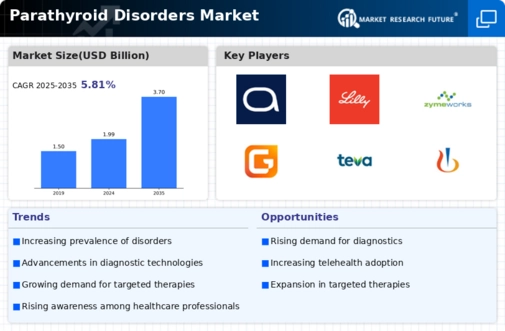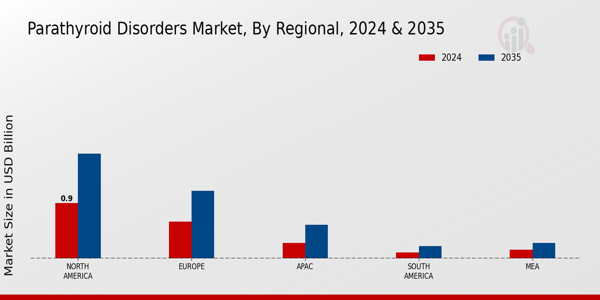Regulatory Support for New Therapies
Regulatory bodies are playing a pivotal role in shaping the Parathyroid Disorders Market by facilitating the approval of new therapies and diagnostic tools. Streamlined regulatory processes and incentives for orphan drugs are encouraging the development of treatments specifically targeting parathyroid disorders. This supportive regulatory environment not only expedites the availability of innovative solutions but also instills confidence in investors and stakeholders. As more therapies gain approval, the Parathyroid Disorders Market is likely to expand, providing patients with access to cutting-edge treatments that address their specific needs.
Rising Incidence of Parathyroid Disorders
The increasing prevalence of parathyroid disorders, such as primary hyperparathyroidism and secondary hyperparathyroidism, is a notable driver for the Parathyroid Disorders Market. Studies indicate that the incidence of primary hyperparathyroidism has risen significantly, particularly among postmenopausal women, with estimates suggesting that it affects approximately 1 in 500 individuals. This growing patient population necessitates enhanced diagnostic and therapeutic options, thereby propelling market growth. Furthermore, the aging population is likely to contribute to the rise in parathyroid disorders, as older adults are more susceptible to these conditions. As awareness increases and more individuals seek treatment, the demand for innovative solutions in the Parathyroid Disorders Market is expected to escalate.
Increased Awareness and Screening Initiatives
Heightened awareness regarding parathyroid disorders among healthcare professionals and the general public is a critical driver for the Parathyroid Disorders Market. Educational campaigns and screening initiatives have led to earlier diagnosis and treatment of these conditions. For instance, the implementation of routine serum calcium and parathyroid hormone level testing in at-risk populations has facilitated timely intervention. This proactive approach not only improves patient outcomes but also contributes to market growth by increasing the number of diagnosed cases. As awareness continues to spread, the Parathyroid Disorders Market is likely to experience a surge in demand for diagnostic and therapeutic solutions.
Growing Investment in Research and Development
The Parathyroid Disorders Market is witnessing a surge in investment directed towards research and development. Pharmaceutical companies and research institutions are increasingly focusing on understanding the pathophysiology of parathyroid disorders, which may lead to the discovery of novel therapeutic targets. This influx of funding is expected to accelerate the development of innovative treatments and diagnostic tools. Moreover, collaborations between academia and industry are fostering a conducive environment for breakthroughs in the management of parathyroid disorders. As R&D efforts intensify, the Parathyroid Disorders Market is poised for significant advancements, ultimately benefiting patients and healthcare providers alike.
Technological Advancements in Treatment Options
Innovations in treatment modalities for parathyroid disorders are transforming the landscape of the Parathyroid Disorders Market. The advent of minimally invasive surgical techniques, such as video-assisted parathyroidectomy, has improved patient outcomes and reduced recovery times. Additionally, the development of novel pharmacological agents, including calcimimetics, has provided alternative treatment options for patients who are not candidates for surgery. These advancements not only enhance the efficacy of treatment but also expand the therapeutic options available to healthcare providers. As these technologies continue to evolve, they are likely to drive growth in the Parathyroid Disorders Market, catering to a broader range of patient needs.


















Leave a Comment